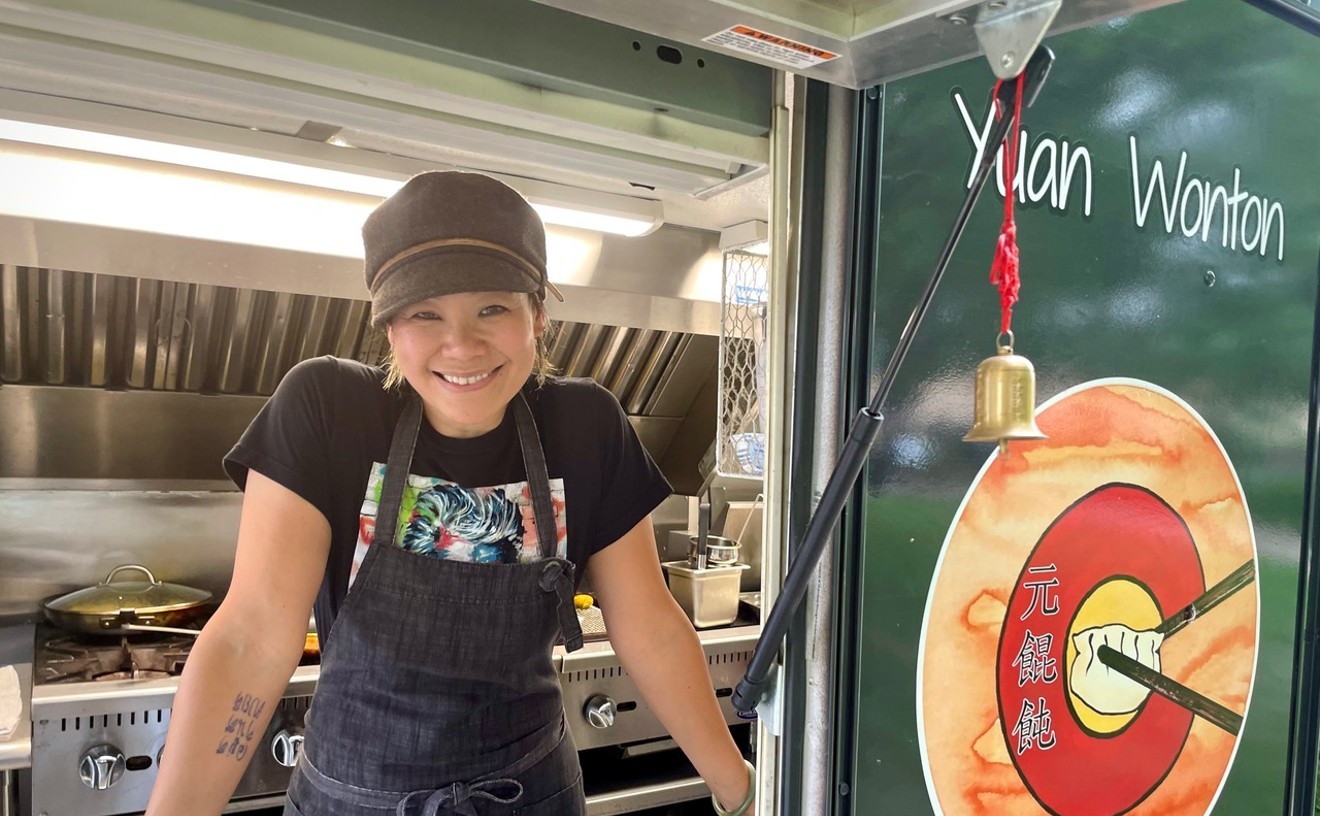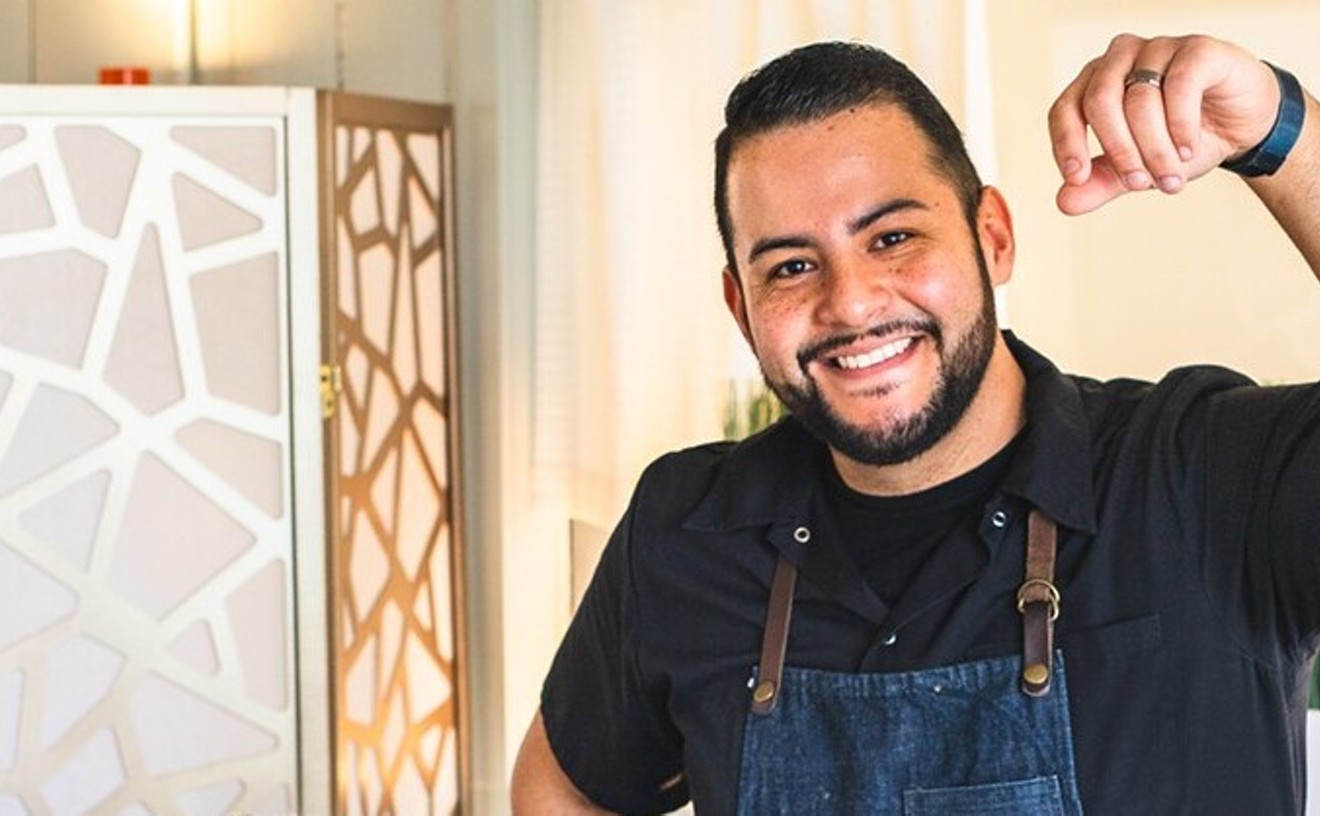Like a sculptor prepping an exquisite block of marble to reveal the statue concealed within, Dale Woerner hesitates for a moment, his just-sharpened ten-inch breaking knife poised for the first crucial cut.
This well-marbled specimen isn’t a slab of metamorphic rock, though, but a nearly 25-pound chuck roll isolated from a locally obtained, recently butchered steer. And instead of chiseling into striated limestone to expose hidden art, Woerner is about to carve away silvery skin and gray-white gristle to break down a fat-streaked hunk of beef — about the size and shape of an unabridged dictionary — to get at eight of the most tender and flavorful cuts no one’s ever heard of: the Denver steak.
The short and recent history of this particular piece of meat is as patchy as its alternating ribbons of intramuscular fat and lean. It was “discovered” — as much as something can be unearthed in a mammal that’s been domesticated since about 5000 B.C. — in the late 1990s
by meat-science professors at the University of Nebraska and the University of Florida, who had been tasked by the beef industry with finding appealing and innovative new cuts to offer consumers.“The Denver cut comes from the most heavily marbled muscle in the entire body.”
tweet this
The Denver steak was introduced to the public in 2009, then virtually disappeared until 2012, when it re-emerged in a few food publications, such as Fine Cooking and Saveur, that declared it “new to the market” and “a new classic,” and then it disappeared again. These days, few chefs or diners around the country — let alone residents of the city for which it was named — are aware of the Denver steak, and it’s almost impossible to find the cut at a restaurant that doesn’t butcher its own beef.
For meat scientist Woerner, the near-magical properties possessed by the Denver steak justify the extra effort involved in extracting the cut from its home in the chuck roll — and for those who don’t break down their own sides of beef on a regular basis, it’s definitely worth seeking out. “The Denver cut comes from the most heavily marbled muscle in the entire body,” says Woerner, an associate professor at Colorado State University’s Center for Meat Safety & Quality. “That makes it immensely rich and intense in terms of flavor. Flavor-wise, it’s just untouchable.”
It’s also a remarkably tender cut. In fact, out of the 39 muscles identified and ranked by the Nebraska and Florida universities in 1998 — from a total of more than 5,600 possible in the animal — the Denver steak is the fourth-most-tender one, behind the number-one tenderloin (from which we get filet mignon), the flat iron and the ribeye cap (aka deckle steak or calotte).
To prove it, Woerner promises to follow up his demonstration on breaking down the chuck to showcase this “uniquely flavored hidden gem,” as he calls it, by grilling up a few in the kitchen next door.
The spacious animal-processing laboratory located in the Monfort Quad at CSU is a hands-on workshop and retail operation that’s officially named Ram Country Meats, the result of a rebranding in September of what had been known as the Meat Lab. This is where students in the animal-science program learn knife skills and make “parts is parts” jokes on their way to managing a dairy operation, marketing livestock-related products or taking over the family ranch. On one side of the room, two students process bacon with something that looks like an electric razor for shaving a giant, while on the other, an industrial-sized Cryovac ramps up to package the pig portions.
Woerner is a big man, 6’ 6”, and originally from Fredericksburg, Texas — unlike much of the Lone Star State, a place better known for its peaches and lavender than its beef production — but he moves with the methodical and gentle grace of a man comfortable with wielding exceptionally sharp knives. His passion for studying the biology and management of livestock brought him to Fort Collins in 2009 to earn his Ph.D. in animal science, which means he knows his way around meat far better than most.
“You have to find the natural separation and natural seams of the muscle,” he explains as he butchers, his knife swooshing back and forth at an alarmingly fast pace as he unhesitatingly chooses which pieces of flesh to pare and which to spare. “We wear these green gloves, by the way, in case something slices off while we’re cutting. The green really shows up on the meat.”
Everyone — students, faculty members, locals who know to buy their just-butchered meats, including the Denver steak, here on Thursdays and Fridays — still refers to this as the Meat Lab. To enter the sterilized and well-equipped space, whose entrance is actually a loading dock, visitors must first remove all jewelry (no one enjoying a hamburger shaped from freshly ground chuck wants to bite into a tiny hoop earring), as well as don gloves and a one-size-fits-all knee-length coat. The lab is kept at a cool-storage temperature of less than 50 degrees, ideal for butchering; the meats are cold enough to keep from spoiling, but warm enough that a well-honed blade cuts through them like butter.
“Breaking down the chuck into steaks renders it into what we call ‘fast-cooking’ cuts rather than slow,” Woerner says. “The Denver steak is such a find because it comes from a part of the animal that normally requires longer cooking times at low heat or braising to make it tender.”
Within a matter of moments, Woerner has several piles of meat sitting in front of him. He weighs each one on an oversized scale. From the 24.75-pound chuck roll, he had set aside the ten-pound chuck shoulder clod — about half the roll and home to several well-known steaks.
Then he broke down the chuck eye roll and the underblade, until he was left with 10.25 pounds of trim — which he says will go into the lab’s ground beef — and 4.5 pounds of finished, grill-ready product, including two Delmonico-style steaks, a couple of chuck eye roasts, and eight glorious, inch-thick Denvers.
And what, exactly, is a Denver steak?
For those familiar with the anatomy of a steer, the simple answer is that it is a true steak — defined as meat cut perpendicular to the muscle fibers, or grain — and a center cut taken from the underblade roast, which has been removed from the chuck eye portion of the chuck roll and trimmed of extraneous fat and connective tissue.
Getting beyond that involves charts and some Latin. A side of beef is often divided into seven primals — from the head of the animal to the other end, these include the chuck and brisket, the rib and short plate, the loin and flank, and the round. Fabricated cuts further divide the meat into about two-dozen subprimals, with such household names as the tenderloin, short ribs and prime rib. The chuck is contained in the shoulder of the animal, above the brisket and next to the rib, and comprises several muscle groups — including the chuck eye roll and the underblade. The underblade is made up of three muscles: the rhomboideus, the splenius and the serratus ventralis, the latter of which is the Denver steak.
That’s where you find it — but how did the Denver steak come to be?
To find out how the Mile High City got a namesake steak, you need to follow the money.
In 1998, the Beef Checkoff Program — a national marketing and research arm of the beef industry — decided to start digging around in carcasses in search of cheaper but still flavorful cuts that could entice consumers to buy more beef.
The Beef Checkoff Program, originally titled the “Beef Promotion and Research Act,” was created by Congress in 1985 with the passage of that year’s farm bill, with the goal of “increasing domestic and/or international demand for beef,” according to the program’s official brochure. To help pay for such an undertaking, beef producers around the country (as well as importers) pay $1 a head every time an animal is sold, throughout its lifetime. Half of the money goes to the Cattlemen’s Beef Board — a standalone organization comprising volunteer beef producers appointed by the U.S. Secretary of Agriculture — for the oversight of national promotions and educational programs, and most of the rest stays in the state where it was collected, to promote local and regional interests. (The exact amount depends on whether a state decides to invest more in national campaigns.)
Remember the “Beef: It’s What’s for Dinner” campaign? That was the Beef Checkoff Program’s crowning achievement. But since the meat-marketing effort got started, in 1992, the industry has been looking for “cool, relevant new cuts,” according to Bridget Wasser, executive director of meat science and technology for the National Cattlemen’s Beef Association.
By the time the late Robert Mitchum was replaced in 1999 by Sam Elliott in the “Beef: It’s What’s for Dinner” ads, the Nebraska and Florida universities had already begun what Wasser calls “muscle-profiling research,” and $1.5 million had been earmarked by the Beef Checkoff Program to support that study, along with educational outreach and tools such as meat-cutting videos.
The NCBA’s headquarters sit in an unassuming business park in Centennial, where the nonprofit is in charge of that educational outreach on the retail and food-service levels, with Wasser and her team traveling extensively around the country — one week they’re in California, the next they might meet with the Northeast Beef Promotion Initiative folks in Pennsylvania — to demonstrate basic butchering techniques and share information on grading, aging and other beef-specific issues.
Wasser, a surprisingly tiny and unassuming woman who wields a butcher’s knife with ease and mastery, has been working tirelessly for the past eight years to get the “opportunity cuts,” as the newly identified steaks are referred to by the industry, onto the plates of more diners.
There have been two waves launched to introduce the inexpensive but tasty cuts — many of which sell for between $6 and $8 per pound, while filet mignon costs around $23 and a porterhouse $14 a pound — to the nation’s more than 1 million beef producers, as well as to meatpackers and the general public.
The first wave revealed the now almost legendary flat iron, an unusual steak in that it’s cut with the grain — as are skirt and flank steaks — from the chuck shoulder clod. Researchers suspected that the flat iron’s potential was high, considering that it’s the second-most-tender cut available from the carcass, Wasser says. And indeed, the flat iron is the beef industry’s
great success story, the cut that made the leap from opportunity to mainstream, and quickly.“And then when they came up with ‘Denver’ for the name, well, we thought we had a hit.”
tweet this
The Denver steak was introduced in the second wave. “We were hoping that the Denver steak would catch on as quickly as the flat iron did,” Wasser says. “But you can’t just go to chefs and say, ‘Hey, there’s this awesome cut, you should offer it.’ There has to be a period where there’s enough knowledge and demand that justifies the cut.”
“You just never know what the market is going to pick up on,” explains Dwain Johnson, a meat-science professor with the University of Florida’s Institute of Food and Agricultural Science and one of the project’s original researchers, who is credited with developing the processing method that allows the Denver steak to be extracted from the chuck roll.
He’s “a little surprised, but not totally,” that the Denver steak hasn’t caught on more, Johnson says. “It has a very robust flavor, and so much marbling.” In fact, the Denver steak’s marbling measures 2.25 times the amount in the tenderloin, which is “what gives the Denver its very flavorful profile,” he adds. “When we did the original analysis, it really stood out. And then when they came up with ‘Denver’ for the name, well, we thought we had a hit.”
The Denver steak is sometimes labeled with other terms, though, which can make it hard for beef-industry insiders to track down the cut — and for consumers to recognize it. Other names include the Denver cut, the Denver chuck steak, the boneless chuck short rib, the underblade steak and the underblade center. In a nod to its plush softness, Japanese chefs call it zabuton, which is also the word for a Zen meditation cushion. “In Europe and Asia, they’ve been isolating versions of the Denver cut for forever,” says Woerner. “Usually they slice it very thin and use it for barbecue rather than steak, but their names for it are all over the place.”
When shown pictures of raw and cooked meat, U.S. focus groups had overwhelmingly chosen “Denver” as a favorite name for one of the new opportunity cuts, but purveyors can call it anything they want, as long as they don’t give it the name of another primal, such as the loin or the rib.
“We can’t make anyone call it the Denver steak; it’s not a requirement, and we have no power to do that,” Wasser says. “All we can do is point to the research that shows people really responded to the Western-sounding names, like the Denver and the Sierra.” The Sierra is the splenius, a less tender piece of meat and one of the others identified from the chuck along with the Denver and a little-known cut inexplicably called “America’s beef roast.”
CSU’s Woerner thinks there’s another obstacle to connecting the Denver steak to consumers, and that would be the meatpacking part of the industry. “The reality is that the packers have never warmed up to the Denver cut enough to put it in a box by itself, partly because of the cost and labor involved,” he says. “It hasn’t been requested enough by chefs or retailers, either, to make it clear to the packers that this cut is deserving of their time and attention.”
Back at the Meat Lab, it’s time to put the Denver steak to the test.
Woerner has fired up the grill to about 700 degrees and divided the eight steaks into two piles. Four hit the searing heat with no seasonings added, but he liberally coats the other four with salt and pepper from the bulk containers on a nearby prep table, “for comparison’s sake,” he says.
“I love to cook, I sure do,” Woerner admits, the faintest hint of Texas tugging at the vowels and his strapping frame barely fitting beneath the hood as he flips each steak over once to sear both sides. “And I really love to cook a good steak.”
After the beef has achieved a textbook crosshatch of grill char, Woerner transfers it to clear, hard-plastic plates with fancy designs on them, ideal for showcasing the simplicity of the steaks. They can be cut and eaten easily using one of the plastic forks that sit in a pile on the stainless-steel table. Oh-so-tender, the steaks sport a buttery, caramel-tinged flavor that’s sweet and strong and, well, beefy. Each steak — and there’s little difference between the seasoned and the not — offers an ideal marriage of taste and texture.
“Flavor is a lot more complex than tenderness,” Wasser says. “We know that marbling is a driver of beef flavor. We used to say that tenderness was number one, but as tenderness has become more consistent over time, we think they’re about even in importance.”
For the University of Nebraska’s study, not only was a test called the “Warner-Bratzler shear force analysis” — whereby half-inch-thick tube-shaped core pieces were pulled from cooked cuts to determine how much force was required to tear them apart — used to determine beef tenderness, but six more factors were analyzed by a trained panel of hungry beef lovers: softness to tongue and cheek, softness to tooth pressure, ease of fragmentation, the mealy quality of muscle fibers, adhesion between muscle fibers, and tenderness of connective tissue.
Flavor is harder to measure, because it’s more subjective.
“Flavor usually comes down to a personal preference,” Wasser says. “Some consumers like the stronger taste of the flat iron, for instance, while others prefer milder cuts from the tenderloin. Other types of meat have the same variations, like white or dark meat on chicken.”
Of course, people can’t know which they prefer until they taste each type of beef cut. And to do that, they have to be able to find them.
It takes calls to 37 top Denver-area restaurants before getting a chef on the other end of the line who not only knows what the Denver steak is, but also has it on the menu. Of the first 36, some chefs try to guess, while others pretend (poorly) that they’re familiar with the cut.
One says, “It’s another name for a Delmonico, right?” Popular steakhouses, including Elway’s and the Capital Grille, don’t offer the Denver cut. A few feature other opportunity cuts — the Kitchen has a ranch steak from Koberstein Farms on its current menu, Basta in Boulder had a hanger steak on the menu in October, and Fruition and Acorn both recently offered bavette (a frilly name for flank steak), while the Populist still does serve bavette, using a Kobe-beef version from Snake River Farms.
Paul Reilly of Beast + Bottle is the first to have the Rocky Mountain oysters to admit that he’s never heard of the Denver steak, though initially he muses that it might have something to do with the “Denver leg,” a well-known name for four cuts of venison from the boneless haunch of the animal: the rump, the silverside, the topside and the knuckle. “I’m intrigued,” he finally admits, “but I have no idea what you’re talking about.”
But Butcher’s Bistro chef-owner Tyson Holzheimer immediately perks up when he hears the query and replies, “Oh, sure, we just had a Wagyu Denver steak on the menu last week.”
Butcher’s Bistro offers the Denver steak frequently as one of the rotating butcher’s cuts du jour, which the restaurant typically presents as steak frites, with a side of lightly seasoned Cajun fries and a spicy rémoulade for dipping. If the Denver steak — or any cut, for that matter — is available in the market display case at the front of the dining room, the kitchen will also cook it to a diner’s specs and serve it with, say, garlic mashed potatoes and oven-roasted broccoflower. Last week, the restaurant’s butcher counter was offering Denver steak for $16 a pound.
“I grew up hunting; that’s where my passion for animals and working with meat came from,” says Holzheimer, a former resident of Montana and Alaska who opened Butcher’s Bistro at 2233 Larimer Street in October 2014 with fellow chef and general manager Scott Bauer, his co- worker for five years at Snooze. “If you kill them, you have to clean them up.”
It was while cleaning up halves of beef in his garage, where he practiced for a year before Butcher’s Bistro debuted, that he discovered the Denver steak and all of its possibilities. “I probably first read about it in a butchering book,” Holzheimer says. “I worked with the chuck roll for five years at Snooze, and I had no idea you could actually break it down and get these incredibly moist and flavorful steaks out of it.” He initially knew the cut as the underblade flap — not to be confused with the sirloin flap, as it sometimes is.
But aside from the steak frites cut du jour, Holzheimer notes, customers typically aren’t very adventurous with the meats that Butcher’s Bistro has available. “We’ve kind of struggled with some home cooks being nervous at trying unfamiliar cuts,” he explains. “At first we brought in a half every other week or so, but we found that we had so many cuts that intimidated people, we were like, shit, we gotta start offering more ribs and strips. But for the ones who have tried the Denver steak, it’s been a huge hit.”
Although Holzheimer may be a lonely fan of the Denver steak, he’s not entirely alone. Top Chef winner Hosea Rosenberg likes the cut, too. Blackbelly Market, his one-year-old Boulder restaurant and butcher shop, breaks down the underblade into Denver and Sierra steaks, and offers the ranch steak from the shoulder clod. “I like the flavor from the Denver,” Rosenberg says, “and I like being able to offer true nose-to-
tail, so that our guests can try a variety of cuts.”“When we grilled them, we were like, ‘Holy crap.’ They were so good, and they were so cheap.”
tweet this
Not everyone feels that the Denver steak is worth its weight, though.
Oliver’s Meat Market, on East Sixth Avenue, has been a go-to butcher shop in Denver for more than ninety years. Rich Oliver, whose great-grandfather Edward Oliver opened the original shop in 1923, says he knows what the Denver steak is, but doesn’t offer it because it’s not profitable. “We break our chucks down differently,” he says. “Getting that Denver steak out results in a lot of leftover, and if you’re just going to throw all that into ground beef, well, you’ll go out of business soon.
“You tell the Cattlemen’s Association that if they’re willing to buy up the trim, then we’ll sell the Denver steak,” adds Oliver, who points out that ground beef sells for between $4 and $5 a pound. “But otherwise, it’s definitely not worth it.”
But both Butcher’s Bistro and Blackbelly Market have figured out how to productively — and deliciously — create dishes that use up any leftovers.
“We add a little bit of ground lamb to the chuck trim mix and make our meatballs out of it,” Rosenberg explains. And Nate Singer, who leads Blackbelly’s three-man butcher team, “does a bunch of different sausages; the trim goes in there, too.”
Although the city of Denver enjoys a far meatier reputation than the Denver steak, there is one multinational retail chain that not only sells the cut, but has also applied the Denver moniker to an entire line of meats. Walmart’s “Choice Denver” offerings include the ribeye, the New York strip, the tenderloin, a variety of roasts and, interestingly, the Denver steak, which Walmart calls the Denver chuck steak.
The Denver line, which Walmart debuted in August, is offered in the meat cases of more than 550 stores in 34 states, including 59 stores in Colorado, according to spokesman John Forrest Ales, who explains that the cuts come to each store already fabricated by U.S. Department of Agriculture facilities across the country. “We wanted to expand our Choice beef offerings and give a wider range of cuts to our customers,” Ales says. “The Denver is a great steak full of beef flavor, with an easy and recognizable name, and that made sense across the line. Also, we’re able to offer these at prices families can afford.”
At the Lakeside Walmart, Lisa Fuentes balances a four-package stack of Denver chuck steaks — priced at $7.28 per pound, with three steaks to a package averaging $10 to $11 — in her arms as she makes her way from the meat department to her cart.
“I don’t know anything about it except that my husband picked these up a few weeks ago for a party, and when we grilled them, we were like, ‘Holy crap,’” says the Wheat Ridge resident and mother of five. “They were so good, and they were so cheap. I came back the next week and thought that must have been a special or something, but nope, here they are, still cheap. And they’re amazing on the grill.”










